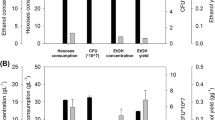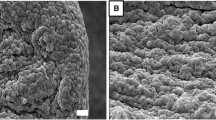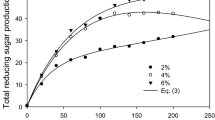Abstract
The maximum growth rate of Saccharomyces cerevisiae ATCC 96581, adapted to fermentation of spent sulphite liquor (SSL), was 7 times higher in SSL of hardwood than the maximum growth rate of bakers' yeast. ATCC 96581 was studied in the continuous fermentation of spruce hydrolysate without and with cell recycling. Ethanol productivity by ATCC 96581 in continuous fermentation of an enzymatic hydrolysate of spruce was increased 4.6 times by employing cell recycling. On-line analysis of CO2, glucose and ethanol (using a microdialysis probe) was used to investigate the effect of fermentation pH on cell growth and ethanol production, and to set the dilution rate. Cell growth in the spruce hydrolysates was strongly influenced by fermentation pH. The fermentation was operated in continuous mode for 210 h and a theoretical ethanol yield on fermentable sugars was obtained.
Similar content being viewed by others
Author information
Authors and Affiliations
Additional information
Received: 25 May 1998 / Received revision: 11 August 1998 / Accepted: 12 August 1998
Rights and permissions
About this article
Cite this article
Palmqvist, E., Galbe, M. & Hahn-Hägerdal, B. Evaluation of cell recycling in continuous fermentation of enzymatic hydrolysates of spruce with Saccharomyces cerevisiae and on-line monitoring of glucose and ethanol. Appl Microbiol Biotechnol 50, 545–551 (1998). https://doi.org/10.1007/s002530051332
Issue Date:
DOI: https://doi.org/10.1007/s002530051332




